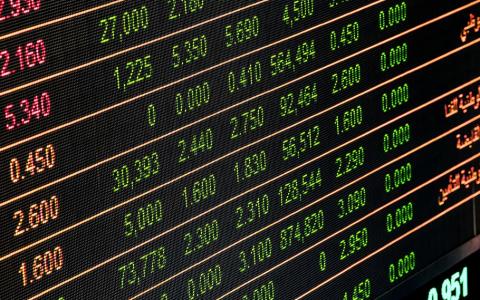
(Bloomberg) Russian assets nosedived as military attacks across Ukraine prompted emergency central bank action and investors braced for the toughest round of Western sanctions yet, wiping out as much as $259 billion in stock-market value.
The cost of insuring Russian debt against default soared to the highest since 2009 and stocks collapsed as much as 45% -- their biggest-ever retreat. The ruble sank to a record low, before paring losses. The Bank of Russia said it will intervene in the foreign exchange market for the first time in years and take measures to tame volatility.
Putin Orders Russian Attacks Across Ukraine in ‘Dark Day’
The military attack cast a shadow over global markets with Ukrainian and Russian assets taking the main blow. President Vladimir Putin’s operation to “demilitarize” Russia’s neighbor prompted international condemnation and a U.S. threat of further “severe sanctions” on Moscow.
“The ball is now on the West’s side, we have to see how far sanctions go -- whether Russia will be kept in the global financial system” said Viktor Szabo, an investor at Aberdeen Asset Management Plc. in London
The Russian central bank made no mention of raising interest rates, but said it will provide additional liquidity to banks by offering 1 trillion rubles ($11.8 billion) in an overnight repo auction. Policy makers have increased the benchmark rate by 525 basis points in the past 12 months to tame inflation.
Heavy Fighting Reported at Airport Near Kyiv: Ukraine Update
The MOEX stock index traded down 35% as of 3:34 p.m. in Moscow. Shares of Sberbank PJSC, Russia’s biggest lender, were down 49%, while natural-gas giant Gazprom PJSC traded 40% weaker.
Russia’s sovereign bonds plummeted, taking some to distressed levels, and the nation’s credit-default swap premium soared above 750. Ukraine’s 2033 dollar debt dived, lifting the yield to 88%, while the local currency market was suspended and limits were imposed on daily cash withdrawals. Stocks in Warsaw tumbled the most in almost two years.
After slumping as much as 9.4% against the dollar, Russia’s ruble traded 2.6% weaker at 83.2525 per dollar.
“If the central bank is in the market then it’s doing so carefully -- but the effect has been achieved,” said Georgy Vashchenko, head of trading operations at the Freedom Finance brokerage. “The ruble will most likely remain under pressure in the near future, but the Bank of Russia is ready to smooth out any emergencies.”
So far, the response by the central bank is more measured than eight years ago when the conflict in Ukraine first flared.
Policy makers raised rates on the first working day after Russia’s parliament approved the use of its military in Ukraine in 2014. With oil prices falling later in the same year, the Bank of Russia ended up lifting its key rate to as high as 17% to defuse a currency crisis.
Oil Soars Past $100 as Russia Attacks Targets Across Ukraine
An increase in borrowing costs may be off the table for now, though a decision to hike rates in the future hinges on how the ruble fares, according to Piotr Matys, a senior currency strategist at InTouch Capital Markets Ltd. in London.
Should the ruble “relatively quickly reach and exceed” 100 against the dollar, the possibility of a rate hike may come into play, he said. Currency options see a more than 50% probability of the ruble touching 100 per dollar in the second quarter, data compiled by Bloomberg show.
“The pace and the scale of ruble depreciation will be crucial,” he said. “Currency intervention is the first line of defense and the central bank amassed significant FX reserves to allow it to step in to slow down the pace of ruble depreciation. The second line of defense would be an emergency rate hike as witnessed at the height of the previous ruble crisis in 2014.”
Putin’s Financial Fortress Blunts Impact of Threatened Sanctions
The central bank may be asked for more support if major Russian companies and banks are targeted by the West. In a late-night statement, U.S. President Joe Biden said that he would announce “further consequences” for Russia later Thursday, in addition to sanctions unveiled earlier in the week.
Biden on Tuesday had set out a partial “first tranche” of sanctions — a modest package that underwhelmed political observers and financial markets -- then followed up with additional measures the following day, including sanctions against Nord Stream 2 AG, the company that built the $11 billion natural gas pipeline connecting Russia and Germany.
Russia’s central bank, which last conducted direct currency interventions in 2014, can resort to other measures to calm the market. Sofya Donets, economist at Renaissance Capital in Moscow, said its options include the possibility of imposing restrictions on cross-border capital flow and assets purchases, focusing especially on domestic ruble debt.
“It’s possible to assume, under the current scenario, that sanctions will be maximally tough,” bringing the central bank’s “political motivations” to the forefront, she said. “That makes them less predictable.”



